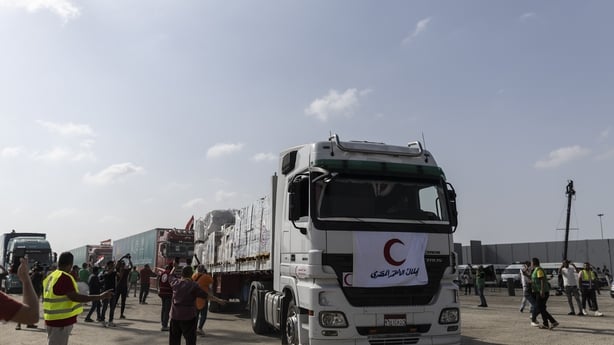In the next 24 hours, difficult decisions will be made on how the small amount of fuel left in Gaza will be used, with the United Nations warning that without a solution to the fuel crisis, their aid operation will come to a stop.
As that happens, millions of people are struggling to find ways to access drinking water. But how has a fuel crisis led to a water crisis in Gaza?
With fuel, electricity and water supplies cut off, people in Gaza are resorting to drinking salty groundwater, increasing the risks of diarrhea, cholera, and other health issues, the United Nations Security Council was told on Tuesday.
Officials from the UN’s Office for the Coordination of Humanitarian Affairs said that electricity and fuel supplies were needed to power the water system in Gaza, and it had 400,000 litres of fuel trucks ready to go into the enclave which would provide fuel for approximately two and half more days.
While welcoming Israel permitting deliveries of aid in Gaza through Egypt in recent days, Lynn Hastings, the UN’s Humanitarian Coordinator in the Occupied Palestinian Territory said "these deliveries are a drop in the bucket compared to the vast scale of needs."
"They amount to no more than four per cent of the daily average volume of commodities entering Gaza prior to these hostilities. Needs are now, of course, significantly greater."
Without fuel, finding and producing clean, drinkable, water is becoming more difficult day by day.
Watch: Gaza's Water Crisis
According to the Palestinian Water Authority (PWA), water production capacity has been at 5% of the normal daily production since 7 October, when Israel imposed a full-scale blockade of the enclave in the wake of the unprecedented murderous attacks into southern Israel by Hamas, the group which controls Gaza.
People are currently living off just three litres of water a day for drinking, cooking, and washing, according to the UN, which falls far below the 50-100 litre minimum recommended by the World Health Organisation (WHO) to meet basic needs.
As desperation sets in, the Reuters news agency reported that some families have resorted to drilling wells in areas near the sea.
How does Gaza get its water?
Israel closed three water pipelines into Gaza since 7 October. One in southern Gaza was later reopened, though only for four hours a day.
Although calls have been made for Israel to turn the water flow through the pipelines back on, the main issue when it comes to Gaza’s water system is not the supply of water itself but the means to power and fuel the system, to clean and pump out water to residents.
Read more: The Israeli-Palestinian conflict: How did it get to this?
Prior to the Hamas attacks, less than 10% of Gaza's water came through the Israeli pipelines.
Since 7 October, Israel has not allowed fuel to enter Gaza, including on the aid convoys coming in through the Rafah crossing, as it says it could be used by Hamas for weapons and vehicles.
"[Fuel] is essential for powering the services that are needed for people to survive," Ms Hastings told the Security Council.
"Without fuel, our humanitarian operation will stop. No fuel means no hospitals functioning, no desalination of water and no baking," she added.

In decades past, Gaza had a natural source of fresh water through an underground aquifer, the Coastal Aquifer Basin, which runs along the Mediterranean coast from northern Egypt, through Gaza and into Israel.
The aquifer is fed by rainwater from Gaza and southern Israel. However, over the years, water has been pumped out of the aquifer faster than it has been replenished by rainwater.
This over-pumping has led to the water supply becoming contaminated with salt water. As well as that, it has become polluted with untreated sewage.
More than 90% of the water pumped from the aquifer now is undrinkable when left untreated, according to the PWA.
In order to make the contaminated water drinkable, Gaza has relied on a number of desalination plants, which extract drinkable water from salt water.
Read more: How tension in the Middle East is moving beyond Gaza and Israel
Since October 7, the three main water desalination plants, previously producing 21 million litres of drinking water per day, have gradually ceased operations, according to UNRWA, the UN agency that assists Palestinian refugees.
As a result, people have become more reliant on small local traders, who use solar-powered desalination equipment to try to clean the contaminated water. They are now the main source of water in the enclave, according to the UN. However, the water produced by them is not always cleaned or properly desalinated.
The knock impact of the absence of clean water is hospitals are unable to clean wounds, food production ceases and disease spreads.
Read more: Doctors report outbreaks of disease among Gaza's displaced
Not alone that, but if you can source a local water vendor, reaching them has become more dangerous. Trying to get to the vendors selling water without using motor vehicles, or on heavily-damaged roads strewn with debris, is an increasing struggle for many in Gaza.
It is part of the reason why humanitarian organisations and the UN say it is critical and increasingly urgent that a permanent aid corridor is opened for unconditional humanitarian supplies to be delivered.







